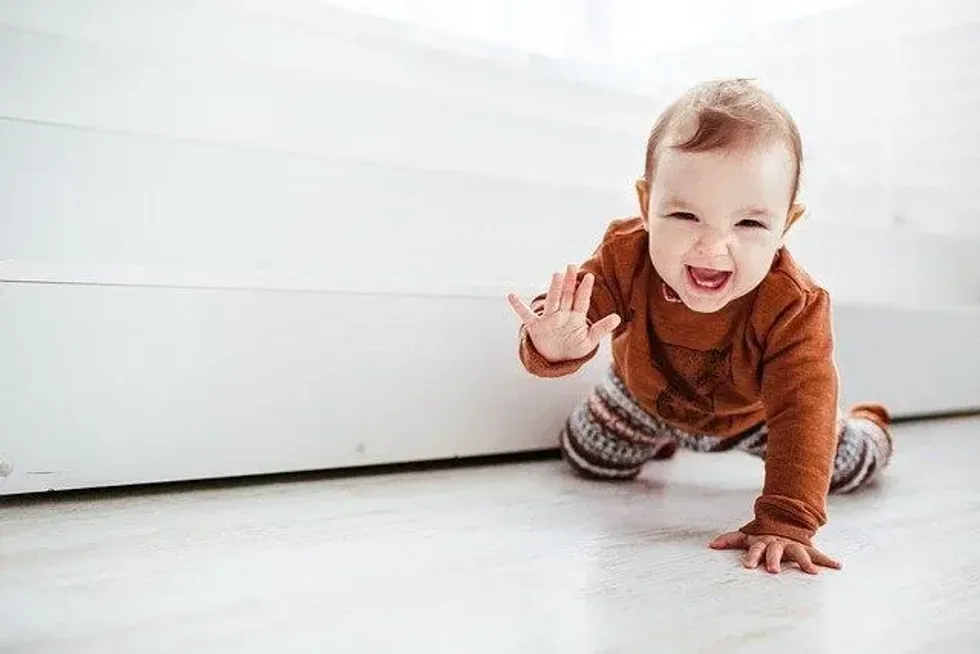Did you know that some babies skip the crawling stage altogether?
Some babies just never crawl and that's totally normal. They can go from sitting to scooting, to cruising and straight on to walking.
Every child is unique and will do things in their own time. Although developmental milestones can feel quite urgent sometimes, there is actually about three months give or take either side, a crawling age of 9-months is just the average.
As parents, it is completely normal to feel worried about our children's development, so if you are concerned that your baby hasn't started crawling yet, check out our guide below.
Parents looking for information about this age can look at our article on [9-month-old schedules], and our follow up article on [10-month-old schedules] too.
Why Is Crawling Important?
The motor skills that come along at this stage of development are the building blocks for physical skills your baby will learn later on. Check out the amazing things that crawling is teaching your baby here:
More precise control of their hands. By putting weight onto their hands, your baby is developing strength and stability through their core and shoulders.
Newly developed coordination will allow for better gripping and ability to hold things like toys and food, and later on, the ability to draw and write.
Developing problem-solving skills, like how to reach their favorite toy without needing your help.
By being about to move around by themselves, your baby is gaining spatial awareness, depth perception and the left and right sides of the body are learning to work together.
Why Isn't My Baby Crawling Yet?
There are a few reasons why your baby could be taking their time. If they are reaching their other developmental milestones, there is unlikely to be a cause for worry, as they are probably just moving comfortably at their own pace.
If you are concerned there is no harm in having your baby checked by a physical therapist who will be able to advise you.
Clothing
Free movement of baby's feet is really important, so make sure that they are in well-fitting, comfortable clothes. A diaper that is too snug can hinder a crawling baby too, so double-check it isn't too tight around their tummy or legs.
Baby's Weight
Heavier babies may take a little longer to crawl, but they can still get there! Once they are on the move they will automatically lose a little of that cute baby chubbiness, but do keep an eye on their weight if you think it's causing problems with movement, and consult your pediatrician if you are worried.
They Aren't Ready
Your baby may simply just not be ready yet. For some babies scooting is preferable, or just sitting and observing for now.
Bow Legs
Bow legs shouldn't impact crawling hugely, and will often straighten out on their own by around 18 months. If you notice the legs becoming bowed or looking more so after age two, you should speak to your pediatrician.
Flat Feet
It takes time for the arch of the foot to develop, so babies are often quite flat-footed, but this will usually disappear by age three, if not sooner. This can be hereditary so it's something to look out for if it runs in your family, but it is unlikely to hinder crawling and walking.
Can I Help My Baby To Crawl?
If your child is showing signs that they are ready to start crawling, you can help encourage crawling in a few simple ways.

Tummy Time
Tummy time allows your baby to build the muscles needed for sitting (around 6- to 9-months) and crawling. You can start tummy time from birth, by laying your baby on your chest, just make sure you are wide awake and won't fall asleep.
As they get a bit older you can lay them down on a blanket.
Place some bright colored toys in their eye line, you can lay down nose to nose to keep them entertained, especially if tummy time is not their favorite. Build up to a little more time each day, even a few minutes is still great.
Note: It is natural for your baby to try and sleep on their stomach once they can roll over on their own, however, this is not considered to be a safe sleep position, so make sure they are always placed on their back to sleep, and that they are awake for tummy time.
Encouragement
A great way of encouraging crawling is to get down on your hands and knees and show your baby how! Babies learn so much by watching. You could make it into a game, crawling towards your baby to make them giggle and showing them how to go from laying down up to the crawling pose.
Freedom Of Movement
Although it is very tempting to hold our babies all the time, children who are held a lot actually get to use their bodies less, the same goes for babies who spend a lot of time in bouncers or walkers.
Letting baby lay safely on a play mat or blanket on the floor with you is a great way for them to discover their hands and feet, get some important tummy time and practice rolling and getting ready to crawl.
Space To Explore
When babies start crawling, they can also start getting into mischief! If you think your baby will be on the move soon, then it's time to get childproofing. Getting down to your baby's eye level will make it easier to spot all the things they might like to grab.
Exercises
Baby yoga is a great way for you to do some stretches with your baby, like moving their legs back and forth and giving them a little foot massage to stretch their arches and toes. Placing a rolled-up blanket under your baby's tummy during tummy time can also help them into the crawling pose.
When your baby is comfortable on all fours, place your palms behind their feet to balance them and give them a solid surface to push back on, and maybe start to crawl forwards.
When To Seek Medical Advice
As parents, it is sometimes hard to know when to seek help, but it is always better to err on the side of caution, so if you do feel worried, your pediatrician is there to discuss your baby's development with you. The following are a few things to look out for if you are concerned that something is wrong.
If your baby seems to have low energy levels, even when they are seemingly well-fed and rested.
If your baby isn't making any attempt to kick their legs or wriggle their arms and feet when you touch them or pick them up, or if they can move their arms, but their feet stay rigid.
If your baby isn't attempting to move themselves towards objects at all (whether by trying to crawl, reaching out, shuffling, or scooting).
If your baby seems to favor one side of their body to the other, for example using the same hand to grab things and never or rarely using the other.
If at age 6-months or older your child does not move their legs to support their body when carried, their legs remain loose and floppy and they don't wriggle them when you pick them up.

Getting Ready To Walk
In order to walk, we need strength in our legs, hips, and core. Crawling will help baby with this, along with tummy time, sitting up, and rolling, but there are exercises you can do together to help them along with those first few steps.
No Shoe Zone
Plenty of time with bare feet will help your baby's little feet to strengthen and move correctly. In the summer try letting baby practice barefoot on the grass for an amazing sensory experience.
Cruising
Cruising is when your baby uses furniture as a way to balance themselves for supported walking. You can encourage this by placing a toy at one end of the sofa for your baby to cruise towards, peekaboo from the side of the sofa will make them giggle as they cruise along!
Kicking
Once your baby is happy to cruise, you can place a soft ball at their feet for them to kick! Switch the ball to each side of their body so they can use both legs.
Walking Together
You can help baby by holding them up, and letting them step with you. If you gently pull their arms forward one at a time, their feet should follow the action and before you know it, they will be taking their first little steps with you!
So although your baby might not be crawling at 9-months, remember that this is just the average age babies crawl, some will be younger, some older. If you do have concerns, don't hesitate to seek medical advice.
Your child's first year is full of new experiences and this is a great time to talk to your pediatrician about developmental milestones.
If this article helped you, take a look at our article about surviving the [12-month sleep regression], or this article on the developmental milestones to expect with your [14-month-old].










